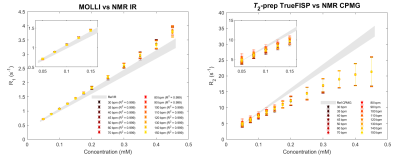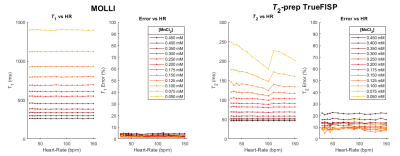Davide Cicolari1, Domenico Lizio2, Patrizia Pedrotti3, Monica Teresa Moioli2, Alessandro Lascialfari1, Manuel Mariani1, and Alberto Torresin2,4
1Department of Physics, University of Pavia, Pavia, Italy, 2Department of Medical Physics, ASST Grande Ospedale Metropolitano Niguarda, Milan, Italy, 3Department of Cardiology, ASST Grande Ospedale Metropolitano Niguarda, Milan, Italy, 4Department of Physics, University of Milan, Milan, Italy
1Department of Physics, University of Pavia, Pavia, Italy, 2Department of Medical Physics, ASST Grande Ospedale Metropolitano Niguarda, Milan, Italy, 3Department of Cardiology, ASST Grande Ospedale Metropolitano Niguarda, Milan, Italy, 4Department of Physics, University of Milan, Milan, Italy
A MnCl2
phantom, characterized through NMR techniques, can be set as intra- and
inter-centric ground-truth reference for MRI relaxation time maps
recalibration, aiming to data validation and harmonization.

Figure 2 MRI results
vs NMR reference values for MOLLI and T2-prep TrueFISP
sequences acquisitions obtained with the MRI scanner: for each MOLLI data-set
the coefficients of determination R2 are indicated assuming a linear
regression model as predicted by the SBM theory.

Figure 3 Simulated
heart-rate dependence of the measured relaxation times and of the errors
calculated through the swSD software analysis. The errors measured with the
usual technique (i.e. the standard deviations calculated in the ROIs on the
relaxation time maps) were in all cases lower than those estimated with swSD
(i.e. the averages calculated in the corresponding ROIs on the SD maps).
